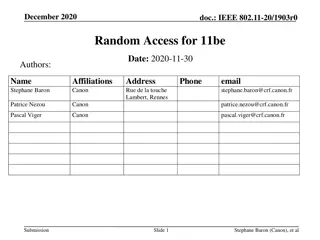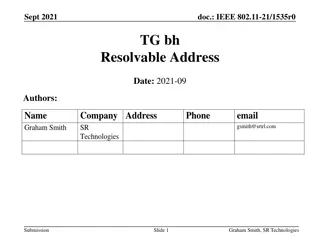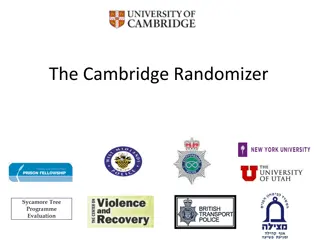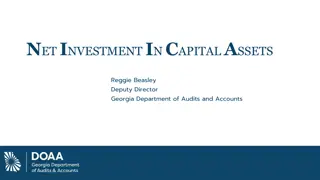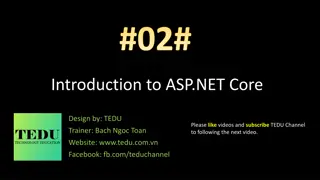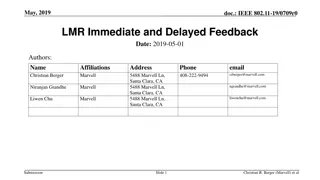Feedback-Directed Random Testing in .NET
Feedback-Directed Random Testing (FDRT) is a technique used to find errors in .NET applications by generating failing test cases based on feedback. This approach, introduced by Carlos Pacheco, Shuvendu Lahiri, and Thomas Ball, leverages properties like reflexivity of equality to identify bugs efficiently. FDRT has been compared with other testing techniques and shown to achieve high code coverage in less time, revealing more errors in a large benchmark of programs.
Download Presentation

Please find below an Image/Link to download the presentation.
The content on the website is provided AS IS for your information and personal use only. It may not be sold, licensed, or shared on other websites without obtaining consent from the author. Download presentation by click this link. If you encounter any issues during the download, it is possible that the publisher has removed the file from their server.
E N D
Presentation Transcript
Finding Errors in .NET with Feedback-Directed Random Testing Carlos Pacheco (MIT) Shuvendu Lahiri (Microsoft) Thomas Ball (Microsoft) July 22, 2008
Feedback-directed random testing (FDRT) classes under test feedback-directed random test generator failing test cases properties to check
Feedback-directed random testing (FDRT) classes under test feedback-directed random test generator failing test cases properties to check java.util.Collections java.util.ArrayList java.util.TreeSet java.util.LinkedList ...
Feedback-directed random testing (FDRT) classes under test feedback-directed random test generator failing test cases properties to check Reflexivity of equality: o != null : o.equals(o) == true java.util.Collections java.util.ArrayList java.util.TreeSet java.util.LinkedList ...
Feedback-directed random testing (FDRT) classes under test feedback-directed random test generator failing test cases properties to check public void test() { Reflexivity of equality: Object o = new Object(); ArrayList a = new ArrayList(); a.add(o); TreeSet ts = new TreeSet(a); Set us = Collections.unmodifiableSet(ts); o != null : o.equals(o) == true java.util.Collections java.util.ArrayList java.util.TreeSet java.util.LinkedList ... // Fails at runtime. assertTrue(us.equals(us)); }
Feedback-Directed Random Test Generation Pacheco, Lahiri, Ball and Ernst ICSE 2007 Technique overview Creates method sequences incrementally Uses runtime information to guide the generation error revealing exceptio n throwing normal used to create larger sequences discarded output as tests Avoids illegal inputs 5
Prior experimental evaluation (ICSE 2007) Compared with other techniques Model checking, symbolic execution, traditional random testing On collection classes (lists, sets, maps, etc.) FDRT achieved equal or higher code coverage in less time On a large benchmark of programs (750KLOC) FDRT revealed more errors 6
Goal of the Case Study Evaluate FDRT s effectiveness in an industrial setting Error-revealing effectiveness Cost effectiveness Usability These are important questions to ask about any test generation technique 7
Case study structure Asked engineers from a test team at Microsoft to use FDRT on their code base over a period of 2 months. We provided A tool implementing FDRT Technical support for the tool (bug fixes bugs, feature requests) We met on a regular basis (approx. every 2 weeks) Asked team for experience and results 8
Randoop .NET assembly Failing C# Test Cases FDRT Properties checked: sequence does not lead to runtime assertion violation sequence does not lead to runtime access violation executing process should not crash 9
Subject program Test team responsible for a critical .NET component 100KLOC, large API, used by all .NET applications Highly stable, heavily tested High reliability particularly important for this component 200 man years of testing effort (40 testers over 5 years) Test engineer finds 20 new errors per year on average High bar for any new test generation technique Many automatic techniques already applied 10
Discussion outline Results overview Error-revealing effectiveness Kinds of errors, examples Comparison with other techniques Cost effectiveness Earlier/later stages 11
Case study results: overview Human time spent interacting with Randoop CPU time running Randoop 15 hours 150 hours Total distinct method sequences New errors revealed 4 million 30 12
Error-revealing effectiveness Randoop revealed 30 new errors in 15 hours of human effort. (i.e. 1 new per 30 minutes) This time included: interacting with Randoop inspecting the resulting tests discarding redundant failures A test engineer discovers on average 1 new error per 100 hours of effort. 13
Example error 1: memory management Component includes memory-managed and native code If native call manipulates references, must inform garbage collector of changes Previously untested path in native code reported a new reference to an invalid address This error was in code for which existing tests achieved 100% branch coverage 14
Example error 2: missing resource string When exception is raised, component finds message in resource file Rarely-used exception was missing message in file Attempting lookup led to assertion violation Two errors: Missing message in resource file Error in tool that verified state of resource file 15
Errors revealed by expanding Randoop's scope Test team also used Randoop s tests as input to other tools Used test inputs to drive other tools Expanded the scope of the exploration and the types of errors revealed beyond those that Randoop could find. For example, team discovered concurrency errors this way 16
Discussion outline Results overview Error-revealing effectiveness Kinds of errors, examples Comparison with other techniques Cost effectiveness Earlier/later stages 17
Traditional random testing Randoop found errors not caught by fuzz testing Fuzz testing s domain is files, stream, protocols Randoop s domain is method sequences Think of Randoop as a smart fuzzer for APIs 18
Symbolic execution Concurrently with Randoop, test team used a method sequence generator based on symbolic execution Conceptually more powerful than FDRT Symbolic tool found no errors over the same period of time, on the same subject program Symbolic approach achieved higher coverage on classes that Can be tested in isolation Do not go beyond managed code realm 19
Discussion outline Results overview Error-revealing effectiveness Kinds of errors, examples Comparison with other techniques Cost effectiveness Earlier/later stages 20
The Plateau Effect Randoop was cost effective during the span of the study After this initial period of effectiveness, Randoop ceased to reveal errors After the study, test team made a parallel run of Randoop Dozens of machines, hundreds of machine hours Each machine with a different random seed Found fewer errors than it first 2 hours of use on a single machine 21
Overcoming the plateau Reasons for the plateau Spends majority of time on subset classes Cannot cover some branches Work remains to be done on new random strategies Hybrid techniques show promise Random/symbolic Random/enumerative 22
Conclusion Feedback-directed random testing Effective in an industrial setting Randoop used internally at Microsoft Added to list of recommended tools for other product groups Has revealed dozens more errors in other products Random testing techniques are effective in industry Find deep and critical errors Scalability yields impact 23
Randoop for Java Google randoop Has been used in research projects and courses Version 1.2 just released 24
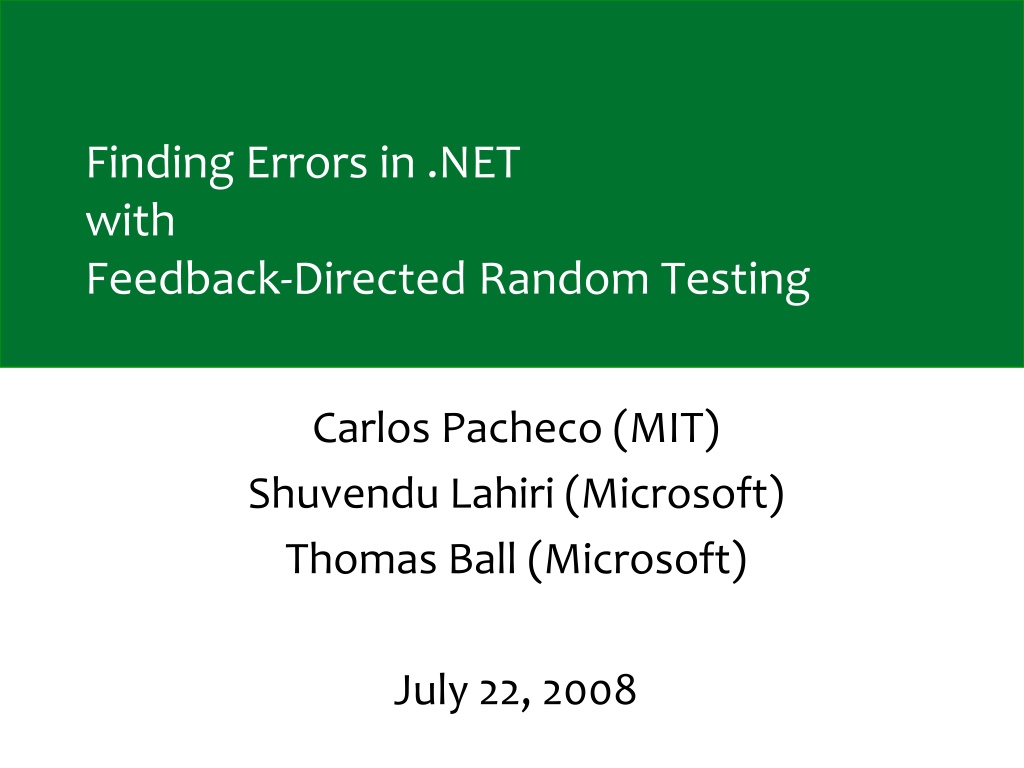
 undefined
undefined

